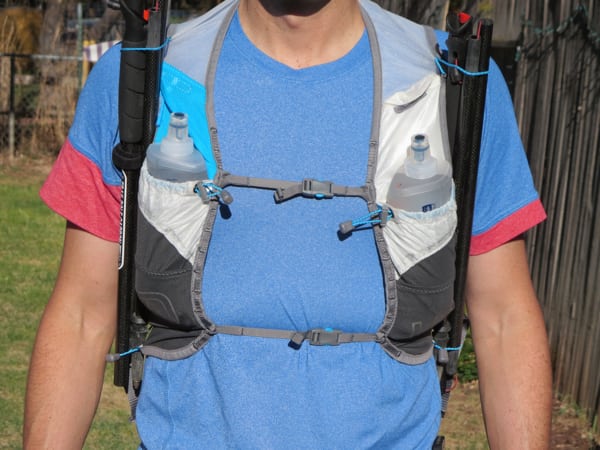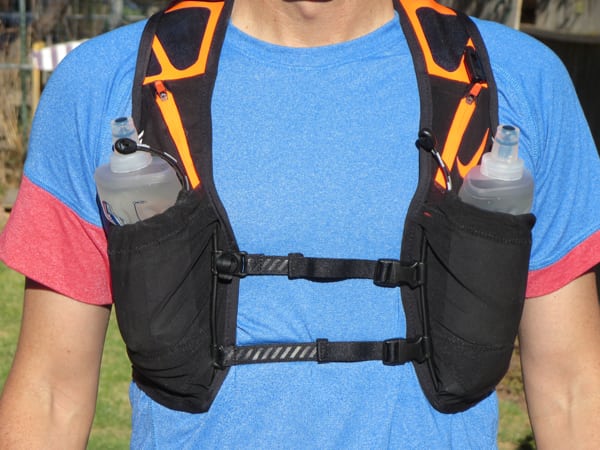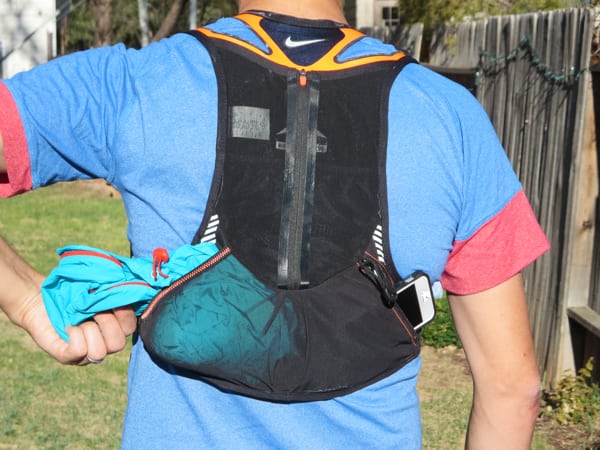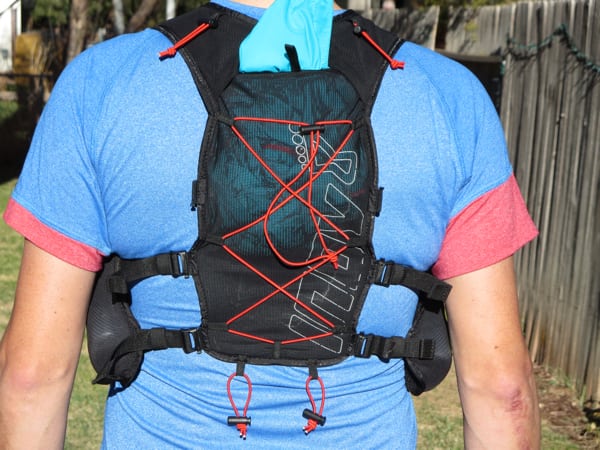Regardless of whether you prefer handheld bottles, waist packs, or hydration vests, the advances in running packs have perhaps been the most remarkable changes over the last several years in our not-so-techy sport. We’ve seen empty packs go from over a pound to less than four ounces through the use of lighter-weight materials, and companies have also found materials that are more durable than ever. We’ve also seen radical changes in how hydration is delivered from the old bladder standby, to the more versatile bottle, to the highly adaptable soft flask.
While some of the most exciting recent updates in pack development have come from high-volume packs, my aim here is to profile some of the newest, and some not so recognized, packs that could make your 2016 season the most efficient yet.
Ultimate Direction Timothy Olson Race Vest 3.0 ($110)
Weighing in without bottles at under 5 ounces, the TO Race Vest 3.0 is by far Ultimate Direction’s most stripped-down vest to date. In fact, from a materials perspective, this vest seems like a quantum leap forward from the highly popular AK Race Vest, which it replaces in the Ultimate Direction line. A slightly stretchy and incredibly durable mono-mesh dominates most of this vest, including the upper back, making it the most breathable vest I’ve ever tested. Roomy bottle pockets on the front accommodate both Ultimate Direction’s 17-ounce body bottles, and just as easily most other bottles from Ultimate Direction and other companies. While cinching the bottles down with bungees is easy, the ‘dump pockets’ beneath the bottles offer ample room for food, garbage, or gloves and a hat. Above the bottle pockets UD adds a Velcro power-mesh pocket and a waterproof pocket with Velcro flap to keep things dry.

Ultimate Direction Timothy Olson Race Vest 3.0 front view. All photos: iRunFar/Tom Caughlan
The back of the vest is primarily open with decent-sized zip pockets, which sit in the small of the back. Ultimate Direction employs an over-under pocket configuration here to allow materials needing to be kept dry away from the sweat of the back, such as a smartphone, and in this pocket there is even a key-ring loop, which I found highly useful. This rear storage isn’t enough to hold more than a thin extra layer, a very light jacket, or a beanie, but it can hold quite a bit of food.

Ultimate Direction Timothy Olson Race Vest 3.0 side view.
The most ingenious aspect of this vest is that UD utilizes a pair of loops on each side of the front of the vest, allowing easy attachment of trekking poles on the go. Initially, I thought this would interfere with arm swing and feel bulky, but UD really designed this well and obviously did a lot of testing.

Ultimate Direction Timothy Olson Race Vest 3.0 back view.
It should be noted that the TO Race Vest 3.0 does not accommodate bladders, and it’s not the type of vest you’re going to take into the mountains for a day full of adventuring in inclement weather. The TO vest is made to go light and fast and rides well, as it is a bit wider over the shoulders than most other vests. Pay attention to fit with this vest, as I felt that it took several runs to dial it in. Most notably, I had difficulty getting the front chest straps to stay tight as the elastic material tended to slide loose when taut. With a 38-inch chest, I elected for a size medium, but I had to cinch everything down to get a fit. If I had to do it again I’d get a small.
Nike Trail Kiger Vest ($185)
This prototype vest was provided by Nike for iRunFar to review, but it seems that the production model will be exactly the same. This is the vest that runners on the Nike Trail Team have been wearing for the past year, most notably at UTMB. While this vest is a bit heavier than some competitors, it seems amazingly durable. It also rides the best of any vest in this review with absolutely no bounce whatsoever, even on steep downhills. While the vest I tested was a size small, I would probably size up in a production model.

Nike Trail Kiger Vest front view.
Again, we see dual front bottle pockets that accommodate both soft flasks and bottles with an easy bungee mechanism, which keeps everything secure. Nike eschews convention for awkward diagonally zippered pockets above the bottles which, sadly, hold very little besides a couple gels or car keys. However, the lumbar area of the vest features both a zippered waterproof pocket and a large dump pocket which accommodates several pieces of clothing, a smartphone or camera, and plenty of food. Additionally, the Kiger vest works with a bladder, both large and small, and there is even a magnetized hose attachment on the front of the vest.

Nike Trail Kiger Vest back view.
In fact, the only things that turn me off about the Kiger vest is that it’s a bit heavier, a bit hotter on the body, and at $185, I can buy several other vests. Overall, though, a solid debut from Nike Trail.
Salomon S-LAB Sense Ultra Set ($130)
By far the most aesthetically pleasing and minimal feeling vest in this group, the lingerie-weight Ultra Set hugs to the body like none other, while standing still. Unfortunately, I had a number of issues with the flimsy materials used in this vest that other wearers may not have had. Firstly, the stretchiness of material around the body causes a loaded vest to bounce quite a bit, and while the pocket configuration was my favorite in the group, I couldn’t get over just how difficult it was to properly cram Salomon’s 16-ounce soft flasks back into their form fitting pockets. During training runs this was merely annoying, but during races this was kind of a deal breaker. Coaxing these flasks into their narrow sleeves meant that I was often walking or slow jogging out of aid stations, losing contact with a group of runners or just getting frustrated.

Salomon S-LAB Sense Ultra Set side view.
Salomon did not employ bungees on the flask pockets of the ultra set, and this vest cannot be used with other bottles like the Skin 5 Set. It does have nice, stretchy dump pockets, upper pockets which can fit a phone, a larger back pocket which did allow me to grab my jacket from on the run. I did have a ton of difficulty with getting the front straps to stay taut, and I ended up knotting the elastic chest straps in the spot that was tight, but this knot caused a hot spot. I also experienced chaffing against my neck from the mesh edges of the fabric, which wasn’t bordered by some softer material. An incredibly sexy vest which may be a little too flimsy for its own good and could use some tweaks in the coming year. In my opinion, it seems best to opt up to the 5-liter vest if you’re looking for a well-fitting Salomon vest.

Salomon S-LAB Sense Ultra Set back view.
Inov-8 Race Elite Vest ($80 approximately)
This is a vest that has surprisingly flown under the radar over the past several years. Retailing around $80, this bargain workhorse can be found for much cheaper. With the Race Elite Vest, Inov-8 gives runners the options of having two flat plastic bottles against the floating ribs or the option to use a bladder. While the flat Inov-8 bottles took a few tries to get used to, they ride extremely comfortably. In fact, this is the only vest I’ve been able to use with hard bottles without getting bruised ribs or chafing. The design of this vest places the flat bottles against the sides of the body below the ribs rather than right in front of the chest. While I can’t verify fit, this may be a better fit option for women as well. The design of these bottles is great, however the conventional plastic bite tops could use some additional engineering.

Inov-8 Race Elite Vest front view.

Inov-8 Race Elite Vest side view.
The Race Elite Vest is rather simple, and its layout includes several small but deep pockets above the bottle pockets. While these hold quite a bit of gel, they are somewhat difficult to open on the fly and they cannot accommodate extra clothing or large items. I have been able to cram a smartphone into these pockets and the tight fit ensures that you won’t lose a thing. The back pocket, made of stretchy power mesh, can either hold a bladder or extra gear, and this pack is plenty big for a 100-mile race. Poles can also be attached to loops on the back of the pack, although I found that to do this I had to take the pack off. At just under 8 ounces, this is a hard pack to ignore due to value and durability. After wearing this pack comfortably for the 2014 Run Rabbit Run 100 Mile, I find that I still reach for it as an old favorite.

Inov-8 Race Elite Vest back view.
Overall Impressions
When buying a lightweight pack, the most important aspect that cannot be ignored is fit. Pocket configuration and even weight can be ignored in the middle of a race, but a bouncing pack at this weight is simply unacceptable. Another thing to consider is whether you like your hydration in easily refillable bottles or bladders on your back which allow you to skip aid stations due to the extra volume if needed. Each of these vests are durably constructed and I’ve taken each for many training runs and races. But, understand that the way these vests fit my torso may be completely different from how they fit you. I’ve talked to many runners who don’t have the same issues I’ve had with the Salomon S-LAB Sense Ultra Set. Additionally, I spoke with a runner this weekend that had a great deal of difficulty with the UD TO Race Vest and ended up returning the item due to poor fit. However, packs are expensive, and if you’re a budget-conscious runner, check out the Inov-8 Race Elite Vest. You won’t be disappointed in any way.
I think that pack choice is individual and it’s best to try on vests and load them for testing if possible. My locally owned running store has allowed me to even fill bottles and jump on the treadmill to see how a vest fits in action. Choose wisely and you can have a piece of gear that keeps you more efficient for years to come.
Call for Comments (from Meghan)
Have you trained or raced with any of these packs? If so, which ones and what were your overall impressions of them?
[Editor’s Note: If you’re leaving a comment regarding a product made by a company with which you’re affiliated (employee, ambassador, etc.), please share your relation in each of your comments on this article. Thanks!]
